JICOSH Home >
About JICOSH >
Incorporating Ergonomic Principles in Safety Management
| Incorporating Ergonomic Principles in Safety
Management
Tomisaburo Toyoshima, 1. The Occasion Leading to Ergonomic Integrations 1-1 The emergency stop button only 15 cm above couldn't be pushed One day fifteen years ago I received report (announcement) of an accident at the plant. A worker had apparently gotten his left hand caught in rollers such as those shown in Fig. 1, and had the upper part of his middle finger cut off. "Unfortunately, the injury was caused by the worker's inability to push the emergency stop button only 15 cm above", explained the report. True, if he had pushed the emergency stop button directly after getting his left had caught, it may only have amounted to a minor accident. I sympathized with the manufacturing site manager's regret, and promptly went to the plant for inspection.  The injured worker's explanation was, "I'm sorry, but when my left hand was caught, it hurt and all I could think about was to pull it out using my right hand. I didn't even see the emergency stop button. It's strange. I still don't know how I could have not seen such a large button." At the site of the accident I tried out the position, with left hand at the rollers and right hand over the left, and discovered that the emergency stop button was completely out of sight. I asked a staff member to bring some cardboard to measure the angle between the direction of the eyes fixed on the left hand caught in the rollers, and the direction to the emergency stop button. It was approximately 17 degrees. The human field of vision is 120 degrees wide horizontally, but narrow vertically, only 5 degrees upwards and 10 degrees downwards, as shown in Fig. 2. In other words, it is only natural that the worker couldn't see the emergency stop button. The regret should have been not in the fact that he didn't push the button, but in the fact that the safety measure was ineffective in placing it in a useless position.  1-2 A different emergency stop button was used for daily inspections I asked the injured worker about his daily safety inspection routine, and discovered he conducted it from the operator panel beside the rollers, by first pushing the start button, then the emergency stop button right beside it. The main purpose of safety inspections is to check the emergency stop function of the machinery, but the added purpose is "to train workers in emergency stop procedures by simulating the same movements in inspection". In cases such as this, daily inspections should be carried out using an emergency stop device reachable from a position caught in the rollers. 1-3 Awareness for the importance of ergonomics Before becoming the Safety and Hygiene Manager, I served a period as the Training Manager (approximately 10 years ago). At the time I had the opportunity to study about human characteristics in the Society for the Study of Ergonomics hosted by Professor Masamitsu Oshima of Tokyo University, where I acquired knowledge about the existence of limitations to human eyesight and field of vision. After this accident, I strongly regretted that I hadn't applied this knowledge to actual practice at the site. The injured worker was still very apologetic as I was leaving the plant. I replied, "You have nothing to apologize for. It was our fault for positioning the emergency stop button out of view, and for not establishing an effective procedure for safety inspection. We should be the ones to apologize." Ever since this incident, I changed my view regarding safety management. Instead of asking "Why did he do that?", I accept that "It is a human characteristic to act that way", based on my understanding of ergonomics and especially the limitations and mistakes caused by human characteristics. Hence, I was inspired to reflect this theory in accident analysis and safety device designs. 2. The Process by which Humans Acknowledge and React - Three Systems The process by which humans acknowledge and react to the outer world is said to be realized through three systems - the sensory system, the central nervous system (CNS), and the motor system. For example, in the outer world, a yellow traffic light, may be considered the "Indication" in Fig. 3. We perceive this as an input through our sensory system, and transmit the information to the CNS. The CNS then references this information to past records for judgement, then decides to stop the automobile by ordering the motor system - legs - to step on the brakes. The legs then carry out the command, and as a result the car stops. This is the route by which humans process information. The three systems mentioned above each have limitations dictated by human characteristics.  Fig. 3 A model of human information processing 2-1 Input: Limitations of the sensory system Humans perceive the outer world mainly through the five sense organs, or in other words, the sensory system. There are limitations to each of the five senses, the characteristics of which must be understood in order to enable safety management applications. 2-1-1 The problems of eyesight Long ago, the JR (Japan National Railway at the time) ticket vending machine was incorporated in stations for the first time, its initial design as shown in Fig. 4. Passengers would insert their money not noticing the blinking "OUT OF ORDER" lamp, and complain when no ticket came out. It resulted in a campaign to abolish the new vending machines. Upon expert analysis, it was discovered that when the customers approach the vending machine with their eyes set on the price indication of "160 yen", a person with eyesight 1.0 would be seeing the "OUT OF ORDER" lamp with the eyesight of only 0.2. In order to see the lamp with an eyesight of 0.2, the lamp size would have to be several times larger than it actually was. Consequently, the "OUT OF ORDER" lamp was moved to a position beside the price indication, as shown in the figure to the right, and the complaints virtually disappeared. In the improved position, a person with eyesight 1.0 with eyes fixed on the price indication could still see the "OUT OF ORDER" lamp with eyesight 0.8.  As explained earlier, there are horizontal and vertical limitations to the field of vision. In addition, work postures are not always constant, as complex work procedures are executed in various postures, such as standing, half-rising, and bent-over positions, on a particular spot. Therefore, emergency stop devices should be located in positions where they can be "seen" and "reached" from all such postures. 2-1-2 Problems of the auditory sense The auditory sense of humans also possesses limitations. Where instant communication is required, sounds such as "Ding, ding, dingc" which transmit information through the hearing are faster and have more coverage than visual information such as written warnings. However, the disadvantage lies in the difficulty in directing the sound. Humans are considered sight-based animals, thus, if the source of alarm is in a constant position and within the field of vision it is easily recognized, but not so otherwise. Auditory communication from behind lacks effect, and must be backed up by visual complementary measures such as signboards. The sensory systems in general are affected by advancing age, a factor accounting for many accidents. Middle-to-old aged people are said to first experience weakening in their hearing for high frequencies. They also tend to have trouble distinguishing one particular sound amongst several others. In a workplace filled with the high frequency sounds of machinery, the alarm from a crane mixed in amongst them may be difficult to distinguish. Therefore, as mentioned above, sight-based measures such as signboards must be used as backup. 2-1-3 Problems of tactile sensation Human tactile sensation likewise has limitations. Fig. 5 shows the U. S. Air Force results of improvement in airplane control lever shapes. In the short time period of two and a half minutes during take-off and landing, the pilots pull the levers twenty to thirty times while watching the control panel. Naturally, the levers are operated by blind touch. In addition, the lever positions vary with plane models thus operation errors could occur easily. This form-coding was developed to prevent such errors. The system takes advantage of the fact that the palm of the hand is the most sensitive area in the human body. This is a good example of ergonomic principle application for safety.  3. Central Nervous System - Selection, Judgement, Decision, and Command The CNS is a system inside our brains. It has the functions of selecting information input from the sensory system, referencing it with memory, deciding on action, and sending a command to the motor system body parts. Any limitations and problems in the various stages of this process must be pinpointed and defined. In the selection stage, we do not reference every bit of information input from the sensory system, but only transmit those which we consider important. 3-1-1 Attention is not sustained - humans are fuzzy beings Accidents are caused by "simple carelessness", thus, follow-up safety measures often consist of merely confirming thorough compliance to safety procedures. It is a human characteristic that we do not hold attention levels high all day. Even while driving, it is said that "A treacherous instant happens once every hour". According to the five levels of consciousness defined by Mr. Kunie Hashimoto, mistakes occur least frequently in Phase 3, the "Normal - clear state", when we are acting enthusiastically. However, this state can continue for only twenty to thirty minutes, accounting for only a quarter of total work hours. Stimulation by ordering to pay attention is said to only make workers fall into the lower Phase 2, the "Normal - relaxed state". This state is most often experienced during regular work and breaks, and accounts for two-thirds to three-quarters of work hours. The attention level is said to fluctuate between one tenth to one one-thousandth of the level in Phase 3. In other words, it is constantly fluctuating between a low state where an alarm may go unnoticed and a high state where the slightest sound may be detected. Hence humans are called fuzzy beings. It is impossible to make workers pay constant attention because, from the fundamental point of view of human characteristics, "attention is non-sustainable", and "the attention level is constantly fluctuating between high and low". Rather it is more effective to consider what actions may occur when attention levels are low and whether or not they present potential danger, in order to consider the safety devices necessary to prevent attention-deficient accidents. As a basic rule, safety measures should rely not on the attention of workers but on facility measures. 3-1-2 Detours in consciousness - carelessness The illustration shown below is the example of a worker on duty who came to the power substation to investigate a power failure accident. Upon arrival, he saw the opening on the floor and the safety guard warning of danger, thus acknowledged the fact that it was dangerous for him to approach the power distribution board farthest to the left. However, as he was inspecting the boards back and forth, he forgot about the danger, approached the opening and tripped over. According to Dr. Karino, the author of "The Story of Carelessness", when people are thinking about several problems at once, they tend to focus on the one that seems the most important, and forget about the others. This phenomenon is called a "detour in consciousness". In this case, the worker on duty realized the potential danger, but was so engulfed in his eagerness to remedy the power failure that when he remembered, it was too late. Fortunately, he only fell over the safety guard and not down to the basement, thus incurred only minor injury.  3-1-3 Thinking about several problems at once Carrying out a task while thinking about other things is something we all do, especially the higher-ranking professionals who endlessly have problems to consider simultaneously. The same may be said for middle-to-old aged workers, who may be worried about, for example, the education, job-hunting, or marriage of their children. Naturally the problems to worry about increase with age. The act of approaching a danger zone while performing a task is exactly the equivalent of approaching danger while thinking about several things at once. It is an "unsafe act", and accident are unavoidable. Therefore, it should be made not possible for anyone to enter a danger zone. 3-1-4 Importance of the safety guard position The insight gained from this accident was the importance of the safety guard position. If it is placed at Position A (within 30 cm) in the Figure to the right, a person would fall to the basement with the safety guard; at Position B (within 50 cm) as in the example, he would either almost fall but stop, or fall; and at Position C (over 1 m), he may fall over the safety guard or, if a plastic container filled with water was placed below the safety guard, he may simply stumble a little. The distance of the safety guard from the opening thus determines the difference between serious or slight injury.  Fig. 7 Safety guard position 4. Limitations of the Motor System 2-1-1 Usual work area and maximum work area: Emergency stops should be reachable and in view Considerable research has been carried out concerning work space and work efficiency. The area in which work can be carried out most easily, fast and accurately is the usual work area, while the second best is the maximum work area. An example of these work areas is illustrated in the figure to below. 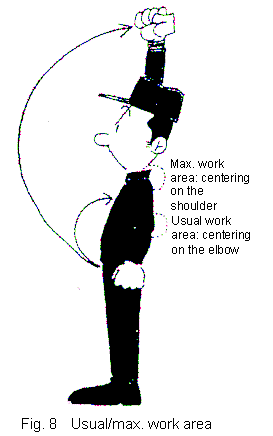 The usual work area is the region centering on the elbow where the hand is moved in a circular motion vertically and horizontally, while the maximum work area is the larger circular area centering on the shoulder. Emergency stop devices such as buttons and ropes should be located at least within the maximum work area to enable accurate and immediate action in crisis situations. The basic principles of emergency safety devices require that they be "reachable and in sight". 2-1-2 Operation error of the forklift lever In Briggs' Experiment ("The Fundamentals of Ergonomics", edited by Messrs. Manabe & Nagamachi), work speed and accuracy were tested on a level work surface. Results were best for an angle of 60 degrees, and following in declining order, directly to the side, 30 degrees, and directly in front. Other experiments also indicated errors in hand movement. Such errors increase when the eyes are closed. According to Mr. A. Japanis, the U. S. Air Force has successfully changed the shape of the knobs (heads) on levers to shapes discernable when wearing gloves, such as round, square, and wave forms, in order to prevent lever operation errors by pilots while monitoring the instrument panel. I have known incidents of forklift accidents where loads have slid off the forklifts and injured fellow workers because the operator mistook the tilt lever for the up/down lever. When I ask for similar accident experiences at the public presentations I give, there are always two or three hands raised, meaning it still happens occasionally. Rather than asking "How could an experienced worker of ten years make such a mistake?", it should be acknowledged that "It is a human characteristic". I have been campaigning for forklift manufacturers to learn from the U.S. Air Force's example and change the shape of the knobs so that operators will know when they touch the wrong lever, but with only partial success. Therefore, in the workplace, it should be enforced that operators always confirm the lever positions during daily inspections, and those who have not operated the forklift for long periods of time always perform practice sessions, as measures to prevent operation errors. 5-1-1 Memory of techniques: experienced workers are most susceptible to injury In the NHK Science special program "The Brain and Heart", Professor Squire of the University of California stated that there are two types of human memory, "the storage of memories and knowledge" and "the memory of techniques". These two types of memory are stored via separate routes, knowledge to the new brain and techniques to the old brain. The memory of techniques, in particular experienced skills, are remembered through repetitive failure experiences in such a way that the body moves automatically. Once stored, the body remembers them, as one naturally remembers how to ride a bicycle even after many years of not riding on one. When a skilled worker is suddenly asked about work procedures and fails to give an answer, it is because he is working relying on his memory of technique and not on his memory of knowledge. However, in today's fast-changing society, machinery modifications and alterations in work procedure happen on an everyday basis, thus relying on acquired "memory of techniques" can have the setbacks of leading to injury. For example, if it is announced at morning roll call that "The machine has been partly modified, so do not touch Part A from now on", that information is stored as "knowledge" and not as "memory of technique". It is the skilled workers who move their hands in the usual procedure and get injured. If so, a site supervisor should never accuse workers with words such as "How could a skilled worker like you make such a mistake?". Instead, he should take measures to make workers practice the movements in front of the machine several times to acquire the new "memory of technique". Other cases where workers are expected to touch rotating machines during preparation work and clean-up but are forbidden to do so when the assembly line is moving, also present examples of work instructions which do not take human characteristics into consideration. 5-1-2 Figures and written characters - vital aspects of site inspection Accidents are often followed by regrets of how such a dangerous spot could have been overlooked. The case where a worker got caught in a rotating bolt is a good example. Although safety and hygiene regulations require that projections on moving parts must either be embedded or covered, few would ever realize, during a daily inspection, that this should also apply to rotating bolts.  According to the narrator, Professor Yoro, in the program "The Brain and Heart" mentioned above, when we store memory of knowledge, figures and written characters pass through the same place called the hippocampus before being stored in different regions. If they pass through the hippocampus simultaneously, it is easier to recollect them together. In other words, remembering figures and written characters together makes it easier to recollect them. In past we tended to educate workers with words and train them with safety inspection procedures on the site (= figures). This is effective in that figures and words are stored simultaneously. In a certain company, safety and hygiene regulations were taught in the system shown in Fig. 8, as part of the safety education. As a result, over six hundred violations of "projections on moving parts" were discovered. In the future, it is expected that application of ergonomics in the wide sense, from human engineering to neuroscience, will become the key factor in effective education. 6. The Five Levels of Safety Devices At present, it is still not possible to fully ensure safety using the former simple "enclosure" systems or the more recent "safety-check type" safety devices. Where systems of even lower safety (such as safety mats) are implemented, ergonomic considerations are essential. As a summary, I would like to introduce the ergonomic considerations to be remembered in applying safety devices. 6-1-1 Pitfalls of safety devices The pitfalls most likely to be encountered in safety inspections lie in the inspection of the safety device itself. Most often we inspect a dangerous point on a machine thoroughly but are reassured if there is any kind of safety device in place, thus move on to the next machine. In actual accidents, however, it may be discovered, for example, that there was an emergency stop button but it was not reachable in the half-rising posture, or that the "safety device", a mere cover with a yellow warning sign painted on it, allowed hands to pass through from various directions. 6-1-2 Basic principles of safety devices In order not to fall victim to such pitfalls, the following points should be considered when designing, using, and inspecting safety devices, for we should never be satisfied with the mere existence of them. 1. Effectiveness Confirm that the safety device is effective for all work postures taken on that spot. For example, there may be cases such as the one described above, where the emergency stop button is reachable standing but not in a half-rising posture. 2. Choose safety devices with higher levels of safety An emergency stop switch, no matter how well positioned, needs to be operated by the discomposed person with his hand caught in the machine. Therefore, compared to a light ray type stop mechanism which senses a person approaching the machine and stops the machine automatically, the safety level of the emergency stop button is considerably lower. The second function of safety inspections should be to check if it is possible to exchange the safety device to one of a higher level of safety. 6-1-3 The Five Levels of Safety Devices Safety devices can be classified into five levels according to their degree of safety, as shown in the following table. Table 1 The Five Levels of Safety Devices 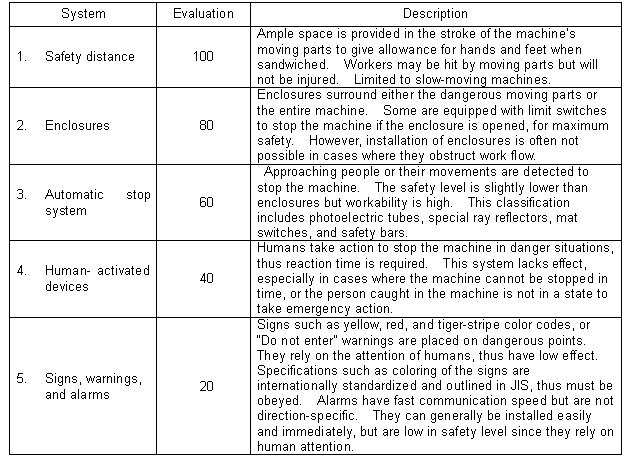 Note: Signs and warnings may not be actual safety "devices" but are included as part of the classification. 6-1-4 Level One: Safety distance checkpoints 6-1-4-1 Safety distance for moving parts The main reason why workers get injured when caught or sandwiched in moving parts is that there is not ample "space" -- safety distance -- provided in the machine to escape such injury. An authorized set of measurement data on human body parts has been published, indicating the maximum standards for heads, hands and feet. Fig. 10 Safety Distances shows an example of West German data which is utilized all over the world, including Japan. Using these values, for example, a stopper may be installed in a place where there is danger of getting feet caught, to maintain the safety distance of 12 cm and avoid danger of being sandwiched. Establishing safety distances is often difficult in existing machines thus must be implemented in the initial stages of design. 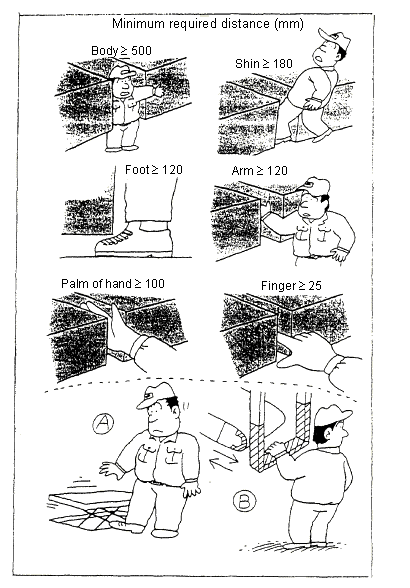 6-4-2 Cover fast-moving parts Even with ample safety distance, injuries may be incurred when hit by hard, fast-moving parts of the machine, in which case safety devices such as covers are required. 6-2 Level Two: Enclosures The enclosure system is one in which the dangerous moving parts or the entire machine are fenced in to isolate them from humans. Often an interlock mechanism using a limit device is installed so that the machine stops when the door is opened. The level of safety is lower than for the safety distances, but higher than the automatic stop systems. 6-2-1 Hands passing through gaps In the enclosure system, since the enclosure itself gives a sense of safety, dangerous parts such as knives inside often remain exposed, and present extreme danger should there be any gaps which may allow a hand to pass through. Workers have been known to get hurt for putting their hands in gaps of 15 cm width. There should be no gaps whatsoever in the enclosure. 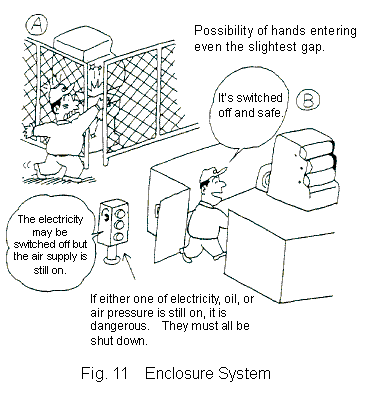 6-2 Is there any kinetic or static energy? Generally machines are powered by three types of energy: electricity, oil pressure, and air pressure (kinetic energy). If the limit switch of the door shuts off only electricity, the enclosure is effective for electrical safety, but remains unsafe regarding oil and air pressures. Any exposed knives and round blades (static energy) also present extreme danger when the enclosure is entered. The switchboard for power sources must be concentrated in a single location so that no switches are forgotten. 6-2-3 Turning the switch on from outside People inside large machines are often not visible from the outside. It is possible for someone on the outside to turn the switch on, unaware of the person within, causing grave accidents. Measures such as using a key switch where the worker carries the key inside, or posting an "Under Repair" sign on the switchboard are necessary in order to prevent such accidents. 6-3 Automatic stop system In the automatic stop system, humans approaching the machine are sensed by devices such as photoelectric tubes and weight-sensitive safety mats, and the machine is stopped. Problems occur when the intervals of the photoelectric tubes are sparse or only the edge of the safety mat is stepped upon, where the device is not activated and the machine not stopped. This system is lower in safety level than the enclosure system but higher than the human-activated devices such as emergency stop ropes. 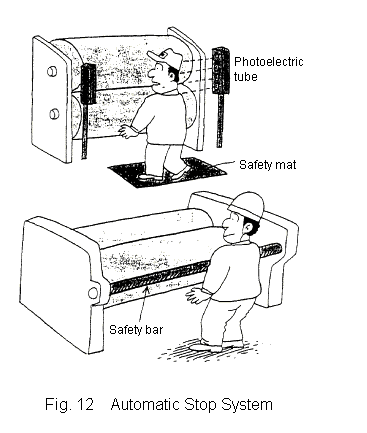 6-3-1 Humans or objects? The disadvantage of the photoelectric system and mat switch is that they can not differentiate between humans or objects. They stop the machines, for example, even when materials are dropped. When stops are too frequent, the worker may become frustrated and switch off the safety device altogether, resulting in an even more dangerous situation. The safety device thus must be installed taking into account the surrounding situation, in order to avoid too many unnecessary error stops of the machine. 6-3-2 Work posture Work postures and work movements are diverse. Even in a single work location, postures may range from standing and half-rising to bent-over positions. Therefore, where the intervals of the photoelectric tubes are too sparse, for example, a hand inserted into the press machine may go undetected. The number of light rays and their arrangement should be calculated so that a hand entering from any work posture is detected. 6-3-3 Will it stop in time? When a person approaches the dangerous parts of a machine and the safety device is activated, the machine must stop in minimum time. Comparing the time A required for the machine to stop after the safety device is activated, and the time B before a body part contacts danger, A must be shorter in order to prevent an accident. Taking the safety bar for the rollers in Fig. 13 as an example, if the arm length is set at a quarter of the roller diameter, the roller stop time (A) must be set at the equivalent of a quarter revolution to be safe. The quarter revolution stop is particularly designed based on a no-load state, thus should be enough to avoid accidents under loaded operation. 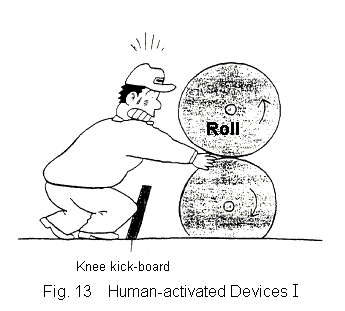 6-4 Human-activated devices Human-activated devices rely on the worker caught in the machine himself to activate the emergency stop rope or button to stop the machine, thus have the lowest level of safety. 6-4-1 Hands not available In human-activated systems, for example if the right hand is caught, the emergency stop rope or button must be activated using the left hand, whereas often the worker is in a difficult position with left hand unavailable for action. Therefore, safety devices such as emergency stop boards activated by the hands, knees, or head, depending on each situation, may be necessary. 6-4-2 Is it in sight and reachable? Human-activated devices such as emergency stop ropes are often installed high overhead, out of sight and reach from the working position. Safety devices must be installed within sight as a basic rule. The range most easily operated by humans is the circular range centering on the elbow - usual work area - and the second fastest is the circular region centering on the shoulder - maximum work area, as in Fig. 5. As human-activated safety devices must be simple and quickly accessible, they must be located at least within the maximum work area. 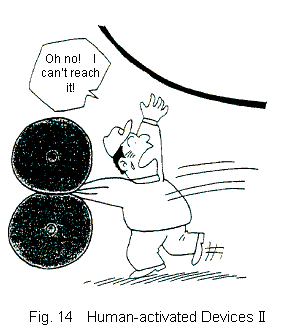 6-4-3 Training is required The use of human-activated safety devices requires a large amount of training so that quick action is possible when necessary. Daily inspections should be considered part of the training process. In the frequent cases where inspections are carried out from the operation panel, the workers are unable to pull the emergency stop rope in an actual emergency situation. 6-5 Signs, warnings, and alarms This category includes painting the dangerous parts of machines in yellow, the warning color in color coding, or placing signboards with "Do Not Enter" warnings. Signs and warnings may not essentially be considered safety devices, but are included for the sake of classification. Alarms are not direction-specific thus must be used together with other devices. The measures in this level rely on human attention thus are lowest in safety. 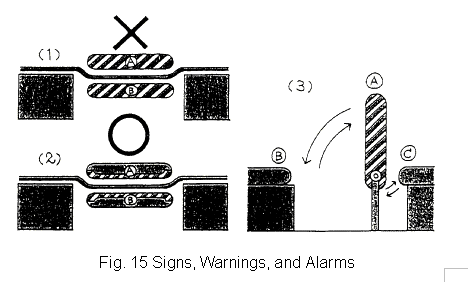 6-5-1 Too much yellow painting lacks effect If all the moving parts are painted yellow as in (1) of Fig. 15, the sense of danger becomes blurred. By painting only the parts that are actually dangerous in the warning color, as in (2), they become more distinct. 6-5-2 The danger of non-moving parts Often only the moving parts as shown in (3) of Fig. 15 are painted in the warning color, but in practice, workers get caught by placing a hand on the opposite non-moving part. Therefore, when painting the warning color, it is only effective when both the moving side and its partner non-moving side are painted. 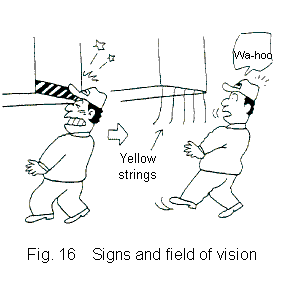 6-5-3 The relationship between signs and the field of vision Signs and warnings rely on human attention, which is known to be less than reliable, as explained earlier. Signs and warnings should therefore be boldly visible, rather than easy on the eye. Fig. 16 shows an example of what type of sign is effective for an obstacle more than 5 degrees above eye level. 6-5-4 Alarms As indicated earlier, alarms are effective in announcing an emergency situation, but lack direction, thus a visual means must be implemented as backup. 6-5-5 Japanese national standards
All signs and displays in Japan are standardized in JIS. All businesses must comply with these indications. Otherwise, they must establish independent color coding regulations for the company, and provide training. However, usually not all work can be completed within one company. Where there is even the slightest interaction with other companies, the JIS color-coding must be applied. 7. Affection is the Key Information that we store in memory is stored intensely and quickly recollected if accompanied by strong feelings. Therefore, it is important in safety education to give a strong impact, using interesting talk techniques, or repeating phrases. The managing supervisor's strong affectionate feelings for his workers is the key to making a strong impacted memory of safety information. Therefore, zero-accident campaigns should be based not on "scolding for safety" but on "praising for safety". |
Copyright (C) 1999- JICOSH All Right Reserved.